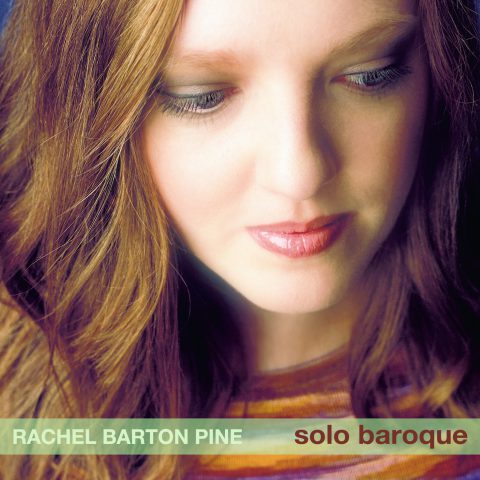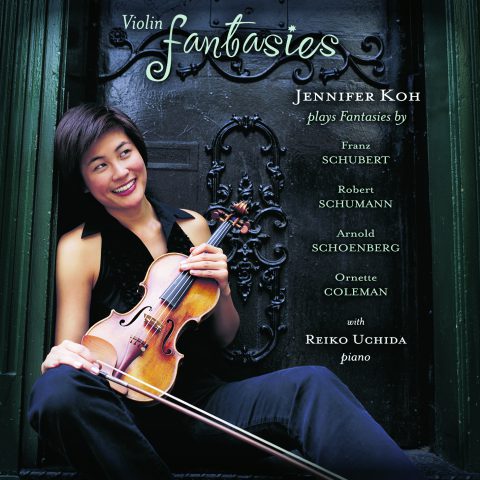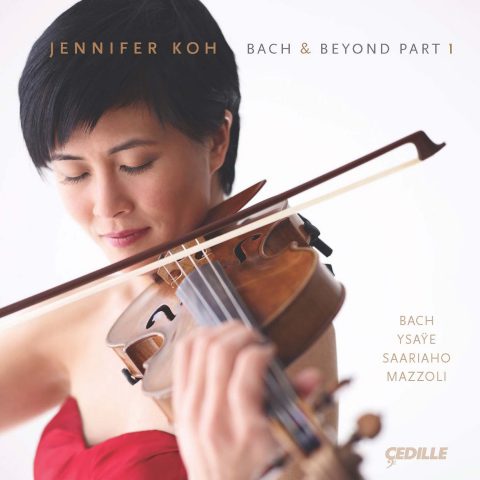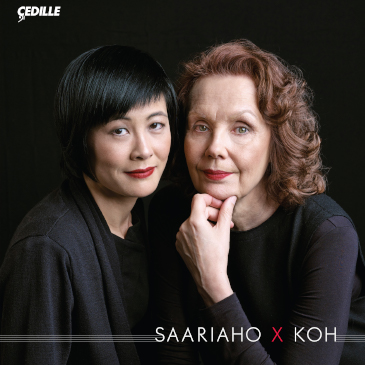Store
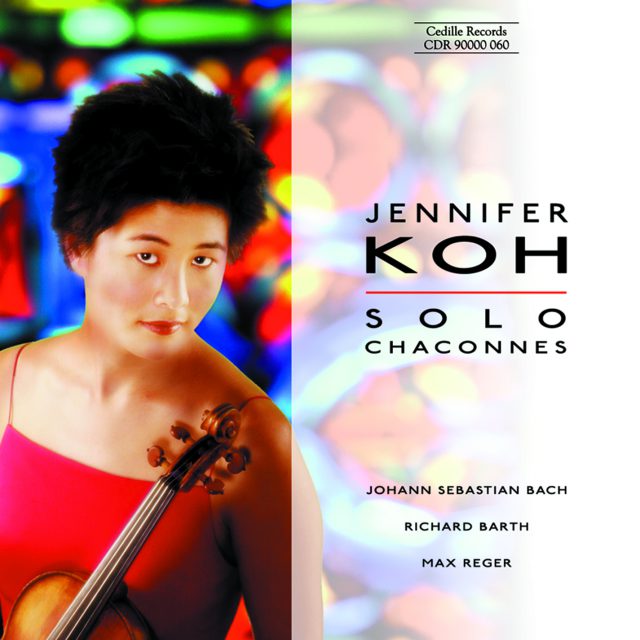
Bach’s Chaconne for Solo Violin, the bedazzling finale to his Partita No. 2 in D minor, has awed audiences and fellow composers for nearly three centuries. Brahms called Bach’s ingenuous meditation on a simple harmonic progression “one of the most wonderful, incomprehensible pieces of music . . . a whole world of the deepest thoughts and the most powerful feelings.”
For her Cedille Records debut and first solo recording, Jennifer Koh performs Bach’s complete Partita and presents two rarely heard late-Romantic solo chaconnes that Bach inspired.
A disciple of Brahms, violinist/composer Richard Barth’s 1908 Ciacona in B minor reflects the virtuoso violin technique of the post-Paganini era and speaks in a rich tonal language. Max Reger’s 1912 Chaconne in G minor updates the baroque form with an iridescent, neo-Wagnerian harmonic palette.
Winner of the top prize at the 1994 International Tchaikovsky Competition and 1995 recipient of a prestigious Avery Fisher Career Grant, Miss Koh applies her “lucid phrasing, sensitivity, and suppleness” (New York Times) to all three works.
Preview Excerpts
J.S. BACH (1685-1750)
Partita No. 2 in D minor for Solo Violin, BWV 1004
RICHARD BARTH (1850-1923)
MAX REGER (1873-1916)
Artists
Program Notes
Download Album BookletEric Wen
Notes by Jennifer Koh: Solo Chaconnes
One of the most distinctive variation forms in Western music, the chaconne consists of a series of melodic elaborations over a repeated bass. This continuous variation form is based on a South American dance that was imported into Spain after the New World conquests of the late-16th century. Found in Spanish guitar books from the early-17th century, the earliest chaconnes feature a simple progression repeated to create a set of variations.
Spanish guitar music was, in fact, responsible for a number of early variation forms including chaconas, pasacalles, and folias. Closely related to the chaconne was the pasacalle (passacaglia in Italian), originally a repeated ritornello passage subjected to variations between stanzas of a song. By the beginning of the 18th century, the designations chaconne and passacaglia were used interchangeably for any set of variations over a recurring basso ostinato. Many Baroque keyboard works adopted these variation techniques; they were also employed in works for the violin. Heinrich Biber wrote the first passacaglias for solo violin. Corelli adopted the folia as the basis for the last of his twelve violin sonatas, Opus 5, published in 1700. By far the most significant chaconne for violin is that which concludes J.S. Bach’s Partita No. 2 in D minor, BWV 1004. The Partita is one of a set of six unaccompanied works — three sonatas and three partitas — for solo violin. Whereas the sonatas are modeled after the sonata da chiesa (church sonata), the partitas are dance suites originating from the sonata da camera (chamber sonata). Bach was particularly fond of the dance suite. In addition to the three for solo violin, he wrote over twenty for solo keyboard, six for solo cello, and four for orchestra.
As with most of his instrumental music, Bach wrote the Partita No. 2 during his years in the service of Prince Leopold at Cöthen, from 1717-23. The work is cast in five movements. The opening four — Allemanda, Corrente, Sarabanda, Giga — are principal dances of the standard Baroque suite. Usually the giga, or gigue, would serve as a suite’s final movement. Bach instead ends his Partita with a monumental Ciaccona, as long as the preceding four movements combined.
Bach’s Chaconne is comprised of 30 variations on an eight-bar theme that leads from tonic to dominant. As with many chaconnes, the theme is presented as a sarabande in 3/4 time with the rhythmic stress placed on the second beat. A solemn, chordal statement of the theme leads into successive elaborations that culminate in broad arpeggiated chords across three and four strings in variations 11-14. After variation 15, the somber world of D minor is transformed into D major. The succeeding ten variations in the major mode grow into a triumphant expression of hope before dissolving back to the minor. The mood of the last five variations is dark and despondent, culminating in a tortuous chromatic sequence against an open A-string pedal. At the very end, the opening theme returns in its original form with a small but significant alteration of the final cadence. This change recalls the opening bar of the Allemanda, associating the ending of the Ciaccona with the beginning of the entire piece.
Bach’s Chaconne is undoubtedly one of the most important works ever composed for the violin. Since its appearance, no composer of chaconnes for the violin could hope to escape its influence. The work’s emotional depth inspired Brahms to write to Clara Schumann: “The Chaconne is for me one of the most wonderful, incomprehensible pieces of music. On a single staff, for a small instrument, the man writes a whole world of the deepest thoughts and the most powerful feelings. If I were to imagine how I might have made, conceived the piece, I know for certain that the overall excitement and awe would have driven me mad.” (Letter from Brahms to Clara Schumann dated June 1877; Johannes Brahms: Life and Letters; translation by Josef Eisinger and Styra Avins; Oxford University Press, Oxford, 1997, pp. 515-6.)
In the same letter, Brahms speaks admiringly of hearing Bach’s Chaconne performed by his close friend, violinist Joseph Joachim. “Since Joachim is not often here,” continues Brahms, “in one way only, I find, can I devise for myself a greatly diminished but comparable and absolutely pure enjoyment of the work — when I play it with the left hand alone! . . . The similar difficulties, the type of technique, the arpeggios — they all combine to make me feel like a violinist!” (ibid.) (Brahms’ piano left-hand transcription is one of many that Bach’s Chaconne has inspired — for many instruments and instrumental combinations. The most celebrated of these is Ferruccio Busoni’s monumental arrangement for solo piano.)
Another violinist in Brahms’ circle was Richard Barth (1850-1923), who owned the manuscript of one of Brahms’ violin masterpieces, the Sonata No. 2 in A, and published a biography of Brahms in 1904. Born in the Saxon town of Grosswanzleben, Barth began his violin studies with Franz Beck, before going to Hanover to work with Joachim from 1863-67. Because he was left-handed, Barth played the violin in reverse, using the left hand for bowing and the right hand for fingering. Despite this unusual playing position, Barth managed to secure a number of important positions. He was concertmaster of several orchestras (in Münster, Krefeld, and Marburg), led a string quartet for many years, and served as music director at the University of Marburg. In 1895, he moved to Hamburg, where he was appointed conductor of both the Philharmonie and Singakademie, and later became director of the Conservatory in 1908.
In addition to his activities as a violinist and conductor, Barth was a skillful composer. Inspired, no doubt, by the high regard for Bach’s Chaconne within Brahms’ circle, Barth composed his own Ciacona for Solo Violin. Though set in B minor, the use of Bach as a model is obvious. The theme is cast in eight bars moving from tonic to dominant, and a group of variations in the major serves as a contrasting central section. Published in 1908, nearly 200 years after Bach’s, Barth’s chaconne reflects the virtuoso violin technique of the post-Paganini era. The work exploits octave passages, lefthand pizzicatos, and ricochet arpeggio bowings. It also employs a rich late-19th century tonal language and contains many surprising modulations, including an enharmonic twist before the final cadence back to the tonic.
The music of Bach was also extremely significant for Max Reger (1873-1916). Already an established organist, Reger began a systematic study in his late-teens of Bach’s keyboard works. He aimed to revive the contrapuntal technique of the Baroque masters, and looked especially to Bach as his model. Like Bach, Reger had a keen interest in the Protestant chorale, and wrote close to 100 chorale preludes for organ. He also composed many preludes and fugues for solo piano, solo organ, and solo violin. In his last years, Reger moved to Bach’s city of Leipzig, where he was appointed Director of Music at the University in 1907.
The rich chromatic language of the neoWagnerians also influenced Reger. He was not interested in writing operas or music dramas, however, nor in the program music so popular with his contemporaries. Reger’s music combined the chromatic language of the late-19th century with the forms of the Baroque and Classical eras; many of his works were cast “im alten Stil” (in olden style). He was especially interested in variation techniques, and wrote several sets of variations, for orchestra and for solo piano, on themes by Bach, Telemann, Mozart, Hiller, and Beethoven.
Reger was particularly fond of the violin, and often performed as pianist with violinists Adolph Busch and Henri Marteau (the latter premiered Reger’s Violin Concerto in 1908). He wrote numerous chamber works for the violin, including nine sonatas with piano, eleven solo sonatas, and several preludes and fugues for unaccompanied violin.
Reger wrote his Chaconne for Solo Violin between 1909-12, publishing it as the fourth in a set of eight works for unaccompanied violin. The highly chromatic theme spans seven bars, evincing Reger’s modernist tendency against symmetrical phrase grouping. There are a total of 27 variations, and, following Bach’s Chaconne, the opening statement of the theme returns to close the work. Unlike with Bach, however, the minor dominates the entire work: there are no major-key variations. Reger’s Chaconne displays a complexity of texture characteristic of the composer’s mature works. The elaborate, but sometimes technically awkward, violin writing expresses a dense harmonic language that often stretches the boundaries of tonality. To quote the eminent musicologist Paul Henry Lang, “[Reger] carries the chromatic contrapuntal subjects to the ultimate dissolution, and in so doing he blazed the trail for modern composers.” (A Pictorial History of Music; W. W. Norton, New York, 1960, p. 197.)
© 2001 Eric Wen
Eric Wen teaches Music History and Theory at the Curtis Institute of Music in Philadelphia. He was Editor of The Strad from 1986-89 and The Musical Times from 1988-90, and was Director of Biddulph Recordings from 1989-2001.
Album Details
Total Time: 57:22
Recorded: Jan. & May 2001 at WFMT Chicago
Producer: James Ginsburg
Engineer: Bill Maylone
Cover Photography: Nesha & Kumiko Fotodesign
Design: Melanie Germond
Notes: Eric Wen
© 2001 Cedille Records/Cedille Chicago
CDR 90000 060
